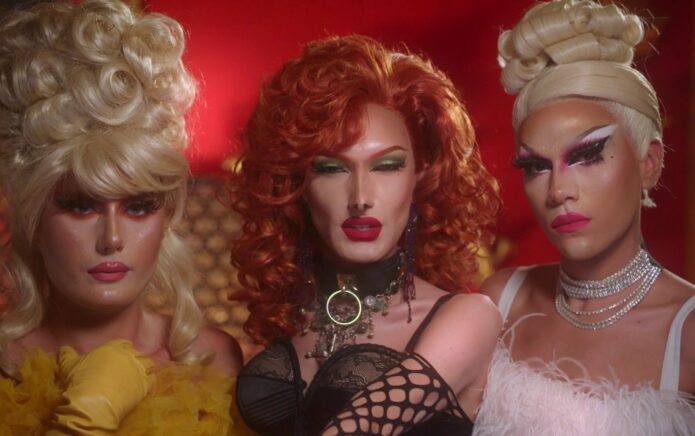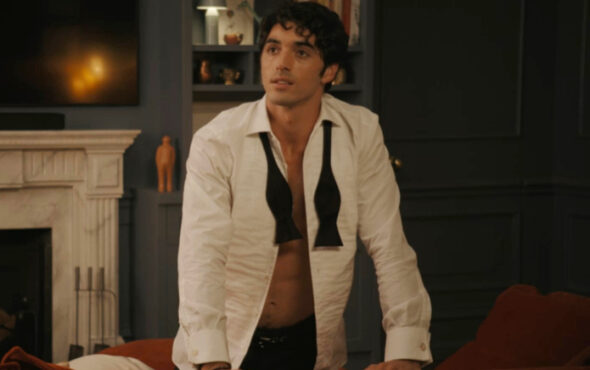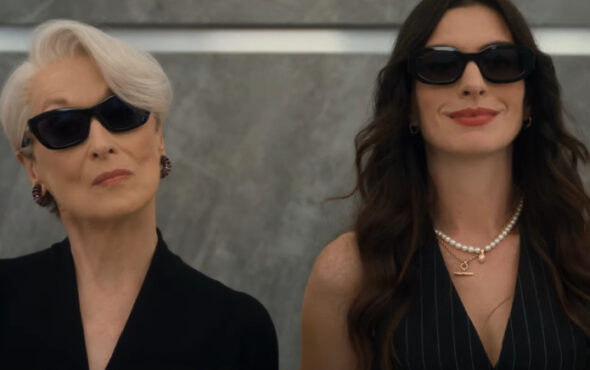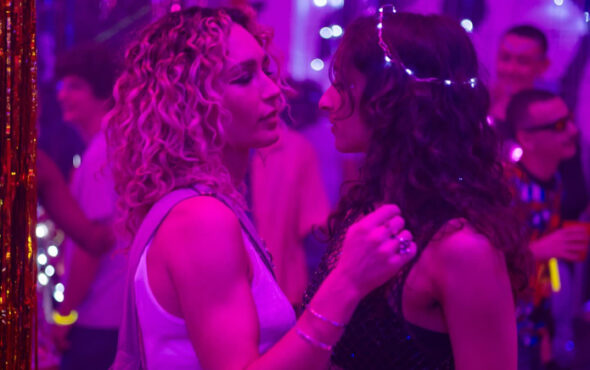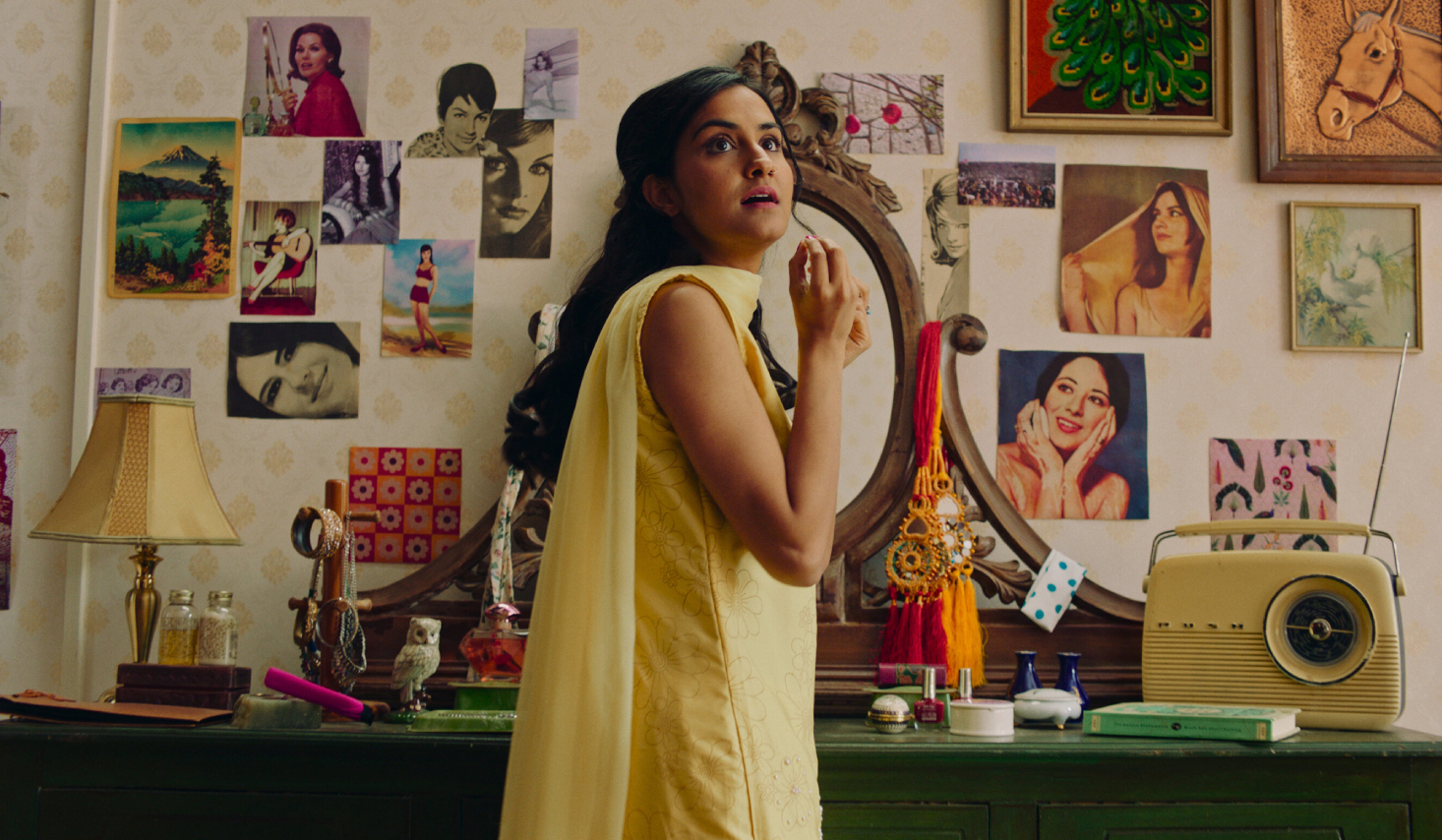
In Fawzia Mirza’s triumphant (and timely) debut feature The Queen of My Dreams, Amrit Kaur delivers a remarkable double performance as Azra, a queer Pakistani-Canadian woman navigating grief and self-discovery after the sudden death of her father, and Mariam, her complex mother whose expectations and cultural pressures shape the fraught dynamics between them.
A profound and evocative meditation on identity and family, The Queen of My Dreams flips the script by centering the often-overlooked joy of queer Muslim life. At a time when DEI initiatives are shrinking, and racism and Islamophobia continue to persist amid a tense political climate shaped by Tr*mp’s second presidency, The Queen of My Dreams’ message of love, resilience and representation has never felt more urgent.
With the film now arriving on digital platforms after a long wait – which Kaur describes as a “message from the universe” – the duo discuss the universal themes that connect their characters across generations and why joy is the ultimate act of revolution. They also share behind-the-scenes stories of the “clip-clopping” variety that brought this vital story to life. (It’ll make sense later!)
GT: The Queen of My Dreams is finally being released after two years! How does it feel for you both, knowing that so many more people are going to be able to see this beautiful and important film for the first time?
Fawzia: I’m definitely excited. On this journey, I’ve had to learn a lot. You want to be an artist and stay an artist, but then, I don’t know if you can be a filmmaker in this day and age without knowing the business side of things. So, I’ve learned a lot about distribution and sales, and the process, and the system… The problems in the system. It’s amazing to have this moment, not just any moment, but one we’re sharing with these partners: Willa and Product of Culture, two women-led distribution companies who truly believe in the project, believe in its message and believe in our audience. They know our audience is out there.
Amrit: Everything Fawzia said! I’m learning vicariously through her. Not nearly as much, but every day, it’s like the journey isn’t over. And I’m like, ‘Oh, okay.’
Fawzia: It’s just beginning!
Amrit: It’s just beginning. But I will say that God, or whoever you believe in – I believe in God – has a very serendipitous way of choosing His or Her release dates. And this is at a time when there’s so much partition and hate in the world. I feel very proud to be an Indian person playing a Pakistani role, especially when things are heightened — in terms of hate, in terms of those two countries. And it’s a representation of love between borders when there’s hate around borders, through different parts of the world. So, I think this represents a lot beyond just the beautiful art that was made. When it was released is a message from the universe as well.
GT: I see what you mean about the timing, because there’s so much joy in this film – which feels important right now. There’s trauma, too, but it takes a backseat. Was that important from the start, for The Queen of My Dreams to centre on the joys of the queer experience rather than the struggles and strife?
Fawzia: A hundred per cent. For me, love is revolution. Joy is revolution. And if we don’t see our joy on screens — if we’re only watching our demise, our death, the violence perpetrated against us — how can we imagine any other future than one filled with trauma? So, part of the mission is to decenter trauma and violence. We all know it, we know it personally, and we’ll project it into every story, no matter what it’s about. But the aim is to decenter that, and instead center joy, hope, possibility and compassion.
GT: For such a long time, queer stories were centred almost entirely on trauma — which is important, of course. That pain is real. But being queer is also so much fun. Everyday life is joyful, it’s hilarious, it’s camp as tits. So it’s great to finally see more films that reflect that joy — stories that actually feel like our community.
Fawzia: Yeah! And when I think about my own journey as a queer person, embracing my queerness unlocked something in me; this sense of expansion, of self-love, of compass, a transcendent way of seeing everyone in the world, and the possibility that we all have inside of us. It allowed me to be more. So I’m just like, ‘Why would our art not reflect the more?’ We talk a lot about manifesting the life we want, so we’ve got to bring that same energy to storytelling. I think sometimes positive, joyful stories get a bad rap as being hokey. And if that’s what my career’s going to be — because I’m telling stories about joy and love and rom-coms and seeing us win — then I’m happy to be not everyone’s cup of chai.
View this post on Instagram
GT: This film explores the intersection of queerness and being Muslim — stories we still don’t see represented nearly enough. Fawzia, why was it important for you to tell this story, and what kinds of conversations do you hope it sparks?
Fawzia: The film centres on Amrit playing Azra, a queer Muslim Pakistani character, and her conflict with her mother. That story unfolds between Canada and Pakistan. But in the same way we can say, ‘Oh yeah, it’s shot in Canada, but it feels like an American story, it feels universal,’ we can say, ‘It centres two Muslim women, and it still feels universal.’ I just find it hilarious, quite frankly, when people think of the Muslim community — over two billion people in the world — and assume there’s no way they could possibly have anything in common with any of us.
And so part of the mission of this film is: look, if I as a queer person can find connection to my Muslimness, y’all can too. You know what I’m saying? At its heart, it’s a mother-daughter story. That’s something we all know. Whether that’s literally your mother, a mother figure, or someone absent from your life, that relationship shapes us — however it manifests in your own life or family. I’m so happy we got to tell this story together, because I think Amrit does such a great job embodying the characters so that people can really just drop in and be like, ‘Yeah, I relate.’
GT: Amrit, you absolutely blew me away in this film. Not only do you balance comedy and drama beautifully, but you also play two very different Pakistani women, in two very different time periods. How did you approach making Azra and Mariam feel connected, yet distinct from each other?
Amrit: Oh, that’s a good question and I’ll go back to Fawzia’s point about universality. The truths of pain and joy at the core of who we are as humans are all the same, regardless of our physical form. So the mere fact that I look like the same person in both characters, and that I’m connecting to those core truths that unite both the mother and the daughter, I think, brings that sense of connectivity.
As an actor, I had so much joy exploring that, and I used many acting exercises — some of which are still my little secrets! But I did embodiment exercises for Azra, and I physically shaped her based on someone I know who walks that way. For Mariam, I did an embodiment of a Maori horse, which is a royal type of horse. The trot is quite forward-leaning, she’s always moving forward in life, whereas Azra is more laid-back. So there were physical things that helped me think about the differences. Internally, I was just thinking about being me, and that’s how there was unity between the two characters, but the physical forms were different.
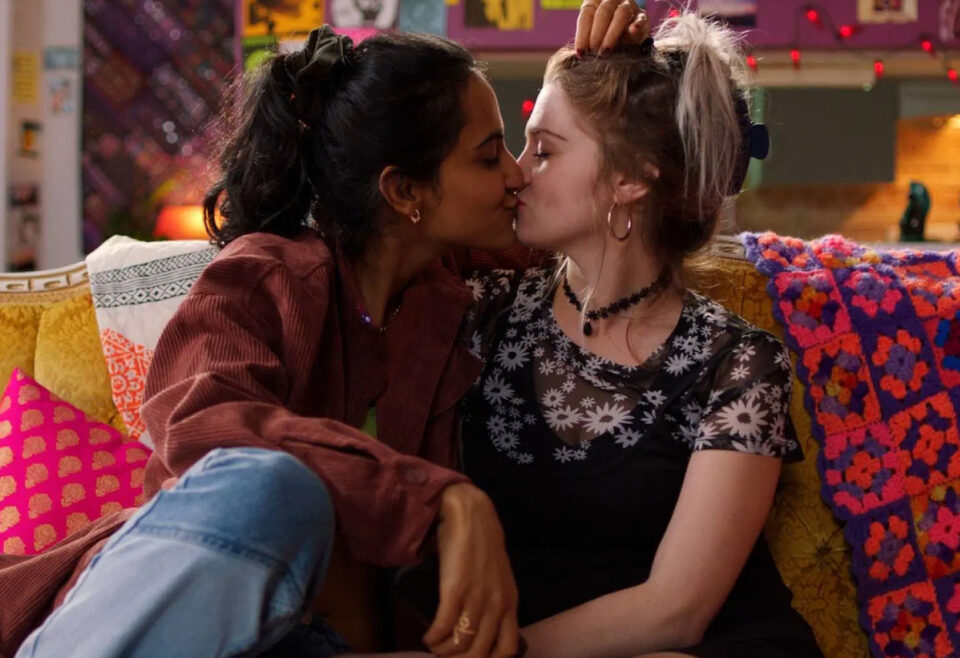
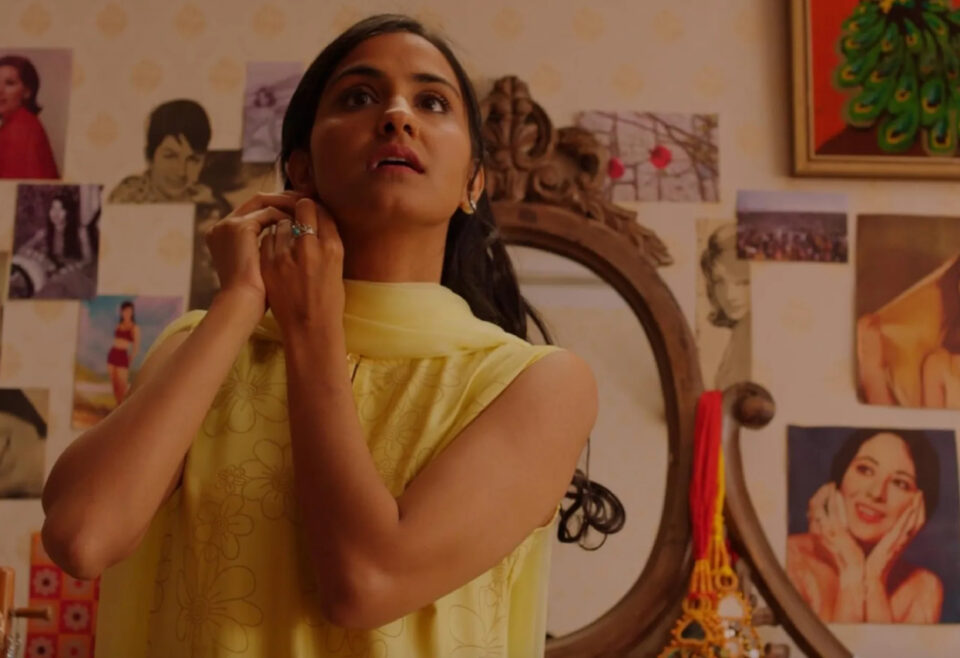
GT: Is there footage of this? It feels important for the world to see this footage.
Fawzia: Clip clop, clippity clop?
Amrit: Yeah, clippity clop! And there’s a scene where it was so funny, because there was a mention of a horse, and I thought, ‘That’s so strange, I’ve been working on a horse for two years.’
Fawzia: I know! And I had no idea. But there’s that scene in the film — and it’s not exclusive to me or my experience — but women are often told, and have historically been told, especially in the West, that there’s a certain way you’re supposed to behave with your body. You don’t laugh with your mouth open, you don’t show your teeth, you sit a certain way, you don’t eat, you don’t enjoy eating, you don’t enjoy anything. You’re basically meant to forget you even have a body.
And that idea, ‘Don’t laugh with your mouth open, don’t show your teeth’, it’s something I kept hearing in culture, so I wrote that into the film. And Amrit was like, ‘This is exactly what I’ve been working on in my embodiment exercise.’ And I thought, ‘That’s awesome.’
Amrit: But that’s exactly why I chose that animal, because that’s what Mariam is. She’s so contained, but she’s also so big. So it made sense that we were connected in that way.
Fawzia: We have some BTS that we’ll probably be releasing soon. So follow @thequeenofmydreamsmovie on Instagram, and you’ll see all that coming out. But I will say, the DVD in the UK that you can buy has a deleted scene on it. That scene doesn’t have Amrit playing Azra, it has young Azra in Nova Scotia and Nimrah Bucha playing her mother. It’s a very sweet scene involving a phone book. It’s something that’s very real for many immigrant families. What immigrant families would do when they moved to a new place was look through a phone book for last names that were theirs or similar to theirs. It didn’t matter whether you were Pakistani, Indian, Muslim, or not — it’s so relatable. You know from the names whose family is whose, what country they’re from, their culture, their religion. So it’s a phone book scene about looking for community.
GT: As you said, this film is a love story between a mother and daughter. Azra has a lot of tension with Mariam, who believes she’s not a “good Muslim girl”. Can you tell me about where that tension comes from and how it evolves over the course of the film?
Amrit: What I think is really interesting about this film is that in the mother-daughter tension, it reveals how the mother imposes her own dreams and desires — who she wants to be or couldn’t be — onto the child. And that always leads to disappointment. Yes, that’s imposed on Azra, but it’s also imposed on young Mariam by her own grandmother. I hope that’s something mothers will take away from this film: that we have to stop — they have to stop — trying to live vicariously through their daughters and instead pursue their own dreams. So Azra’s angry, and I relate to it because that was me – still me. I’ve done every possible thing my family did not want me to do.
Fawzia: And it’s part of the whole concept of Amrit playing both roles, that history repeats itself. We see that all the time. I mean, literally, the nineties fashion — that’s enough right there. Everything nineties is now, right? But history repeats itself in every single way. We move in circles. Part of the symbolism in the film — the circle, the repetition, the roundabout, the singers — is about that repetition happening. The tension is also that we think we’re so different from those who came before us, and we think we’re so unique — and we’re not. Of course we’re individuals, and we’re all our own person, but we’re usually not inventing anything. We’re just repackaging something else.
GT: In this film, there is a supporting character called Rani, played by trans actress Zara Usman, who was in the flashbacks of 1969 Karachi. Was her inclusion to highlight how trans people have always existed within this space and time period in particular?
Fawzia: A hundred percent. We can’t make every movie tell every story. As writers, we should be cautious about telling those stories if it doesn’t feel like it matters. But when I think of Pakistan, I think of a place that has always had trans people. The subcontinent has always had trans people. We know that, across the world, trans people have always been here and are ancient. So it felt really important, in that space, in that film, while shooting in the country, to include the people who have always been there.
In the same way, you have the Chinese restaurant. The Chinese restaurant is a moment to highlight something incredible. Instead of it just being a scene where our leads go to enjoy Chinese food and have this moment, there was an opportunity to show this incredible Chinese Muslim community that speaks Urdu — people who left China, sought refuge in countries like Pakistan, and then became a cornerstone of generations, communities and the country.
It’s just a matter of: how do you do service to the community in that way? For the Chinese character, I consulted with the actress who plays her. She’s Chinese and speaks Urdu, and we talked about the role and shaped it together. For Zara, I consulted with one of the largest local trans organisations. The scene was actually different initially, and I changed it to make sure I was meeting not the needs of my movie, but what they needed for their aspirational future. And the request was: a character who just lives.
The flight attendant storyline actually came later, as an adjustment, and I can’t imagine the film without it. We don’t really talk about this character as a trans character – she’s just a woman. And whether you think, ‘No, she’s trans,’ or not — that’s not the point. The point is: we have always been here. And it turns out, I was told later by a fellow filmmaker that there was a quite well-known flight attendant for the airline in the sixties who was passing for many, many years. He said, ‘Oh my God, I can’t believe you put that in there because of her.’ And I didn’t. It’s just that when you are acknowledging and respecting the people of the place you are telling stories about — when you’re doing it authentically — it will just feel authentic.
View this post on Instagram
GT: What stories do you both hope to tell next? As an actor and director? As artists?
Fawzia: I’m a hopeless workaholic — for better or for worse — but I’m just determined to push joy into the world. I’m attached to direct a few rom-coms that I didn’t write. And I have a film that I did write, which is a queer besties heist comedy that I’m really excited to put out into the world. I directed on a TV series called Deli Boys, which is on Hulu in the US, and I can’t wait to direct more television. Part of the mission is also supporting other people’s careers. So there are a few features and short films by some really talented, incredible filmmakers whose work my wife and I are executive producing through our company, Baby Doll Productions. That’s the general wash of what’s up.
Amrit: I mean, I think my through-line is playing brown girls who are just humans. It’s funny that we’ve been talking about universality, because that’s what Bela was — she was just a human. It didn’t seem like she was from a different culture or anything like that. She was just one of us. And that’s what I want people to see with Azra and Mariam, that there’s a universality there. It just also happens that my outer appearance looks like this. I want to continue that trajectory, especially in this moment where DEI funding is shrinking and there’s so much assholery directed at immigrants. We’re just humans. And while I’m not technically an immigrant, in some ways I am, and I definitely look like what people here would call an immigrant. So I’m continuing to make art that reflects that journey, and the kind of art I would have loved to see as a child.
Fawzia: A great response. Amrit’s a great example, and I hope I am too, of fighting as artists not just for the art itself, but for our values. I think we’re both deeply values-driven. And what’s the point of making art if we can’t live out those values? That extends to fighting for immigrant rights, fighting for queer and trans people to have rights, fighting for Palestine and against the genocide in Gaza. That is part of the liberation that we all deserve.
The Queen of My Dreams is out now.
